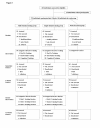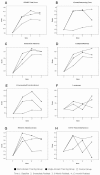The effects of multi-domain versus single-domain cognitive training in non-demented older people: a randomized controlled trial
- PMID: 22453114
- PMCID: PMC3364144
- DOI: 10.1186/1741-7015-10-30
The effects of multi-domain versus single-domain cognitive training in non-demented older people: a randomized controlled trial
Abstract
Background: Whether healthy older people can benefit from cognitive training (CogTr) remains controversial. This study explored the benefits of CogTr in community dwelling, healthy, older adults and compared the effects of single-domain with multi-domain CogTr interventions.
Methods: A randomized, controlled, 3-month trial of CogTr with double-blind assessments at baseline and immediate, 6-month and 12-month follow-up after training completion was conducted. A total of 270 healthy Chinese older people, 65 to 75 years old, were recruited from the Ganquan-area community in Shanghai. Participants were randomly assigned to three groups: multi-domain CogTr, single-domain CogTr, and a wait-list control group. Twenty-four sessions of CogTr were administrated to the intervention groups over a three-month period. Six months later, three booster training sessions were offered to 60% of the initial training participants. The Repeatable Battery for the Assessment of Neuropsychological Status (RBANS, Form A), the Color Word Stroop test (CWST), the Visual Reasoning test and the Trail Making test (TMT) were used to assess cognitive function.
Results: Multi-domain CogTr produced statistically significant training effects on RBANS, visual reasoning, and immediate and delayed memory, while single-domain CogTr showed training effects on RBANS, visual reasoning, word interference, and visuospatial/constructional score (all P < 0.05). At the 12-month posttest, the multi-domain CogTr showed training effects on RBANS, delayed memory and visual reasoning, while single-domain CogTr only showed effects on word interference. Booster training resulted in effects on RBANS, visual reasoning, time of trail making test, and visuospatial/constructional index score.
Conclusions: Cognitive training can improve memory, visual reasoning, visuospatial construction, attention and neuropsychological status in community-living older people and can help maintain their functioning over time. Multi-domain CogTr enhanced memory proficiency, while single-domain CogTr augmented visuospatial/constructional and attention abilities. Multi-domain CogTr had more advantages in training effect maintenance.
Clinical trial registration: Chinese Clinical Trial Registry.
Registration number: ChiCTR-TRC-09000732.
Figures



Similar articles
-
Efficacy of multi-domain cognitive function training on cognitive function, working memory, attention, and coordination in older adults with mild cognitive impairment and mild dementia: A one-year prospective randomised controlled trial.J Glob Health. 2023 Jun 30;13:04069. doi: 10.7189/jogh.13.04069. J Glob Health. 2023. PMID: 37387548 Free PMC article. Clinical Trial.
-
The Moderating Role of COMT and BDNF Polymorphisms on Transfer Effects Following Multi- and Single-Domain Cognitive Training Among Community-Dwelling Shanghainese Older Adults.Front Aging Neurosci. 2018 Jul 5;10:198. doi: 10.3389/fnagi.2018.00198. eCollection 2018. Front Aging Neurosci. 2018. PMID: 30026692 Free PMC article.
-
Evaluation of the Implementation and Effectiveness of Community-Based Brain-Computer Interface Cognitive Group Training in Healthy Community-Dwelling Older Adults: Randomized Controlled Implementation Trial.JMIR Form Res. 2021 Apr 27;5(4):e25462. doi: 10.2196/25462. JMIR Form Res. 2021. PMID: 33904819 Free PMC article.
-
Multi-Component Interventions and Cognitive Health: A Scoping Review.J Gerontol Nurs. 2017 May 1;43(5):39-48. doi: 10.3928/00989134-20170131-01. Epub 2017 Feb 2. J Gerontol Nurs. 2017. PMID: 28152154
-
The Mental Status Examination.In: Walker HK, Hall WD, Hurst JW, editors. Clinical Methods: The History, Physical, and Laboratory Examinations. 3rd edition. Boston: Butterworths; 1990. Chapter 207. In: Walker HK, Hall WD, Hurst JW, editors. Clinical Methods: The History, Physical, and Laboratory Examinations. 3rd edition. Boston: Butterworths; 1990. Chapter 207. PMID: 21250162 Free Books & Documents. Review.
Cited by
-
Comprehensive family therapy: an effective approach for cognitive rehabilitation in schizophrenia.Neuropsychiatr Dis Treat. 2015 May 21;11:1247-53. doi: 10.2147/NDT.S83569. eCollection 2015. Neuropsychiatr Dis Treat. 2015. PMID: 26056456 Free PMC article.
-
The effect of cognitive training on the brain's local connectivity organization in healthy older adults.Sci Rep. 2019 Jun 21;9(1):9033. doi: 10.1038/s41598-019-45463-x. Sci Rep. 2019. PMID: 31227777 Free PMC article.
-
The impact of behavioral interventions on cognitive function in healthy older adults: A systematic review.Ageing Res Rev. 2019 Jul;52:32-52. doi: 10.1016/j.arr.2019.04.002. Epub 2019 Apr 17. Ageing Res Rev. 2019. PMID: 31002885 Free PMC article.
-
Study protocol for a cluster randomized trial of the Community of Voices choir intervention to promote the health and well-being of diverse older adults.BMC Public Health. 2015 Oct 13;15:1049. doi: 10.1186/s12889-015-2395-9. BMC Public Health. 2015. PMID: 26463176 Free PMC article. Clinical Trial.
-
The "FitBrain" program: implementing exergaming & dual-task exercise programs in outpatient clinical settings.Front Sports Act Living. 2024 Dec 6;6:1449699. doi: 10.3389/fspor.2024.1449699. eCollection 2024. Front Sports Act Living. 2024. PMID: 39712081 Free PMC article.
References
-
- Ball K, Berch DB, Helmers KF, Jobe JB, Leveck MD, Marsiske M, Morris JN, Rebok GW, Smith DM, Tennstedt SL, Unverzagt FW, Willis SL. Effects of cognitive training interventions with older adults: a randomized controlled trial. JAMA. 2002;288:2271–2281. doi: 10.1001/jama.288.18.2271. - DOI - PMC - PubMed
-
- Valenzuela MJ, Sachdev P. Brain reserve and dementia: a systematic review. Psychol Med. 2006;36:441–454. - PubMed
Publication types
MeSH terms
LinkOut - more resources
Full Text Sources

